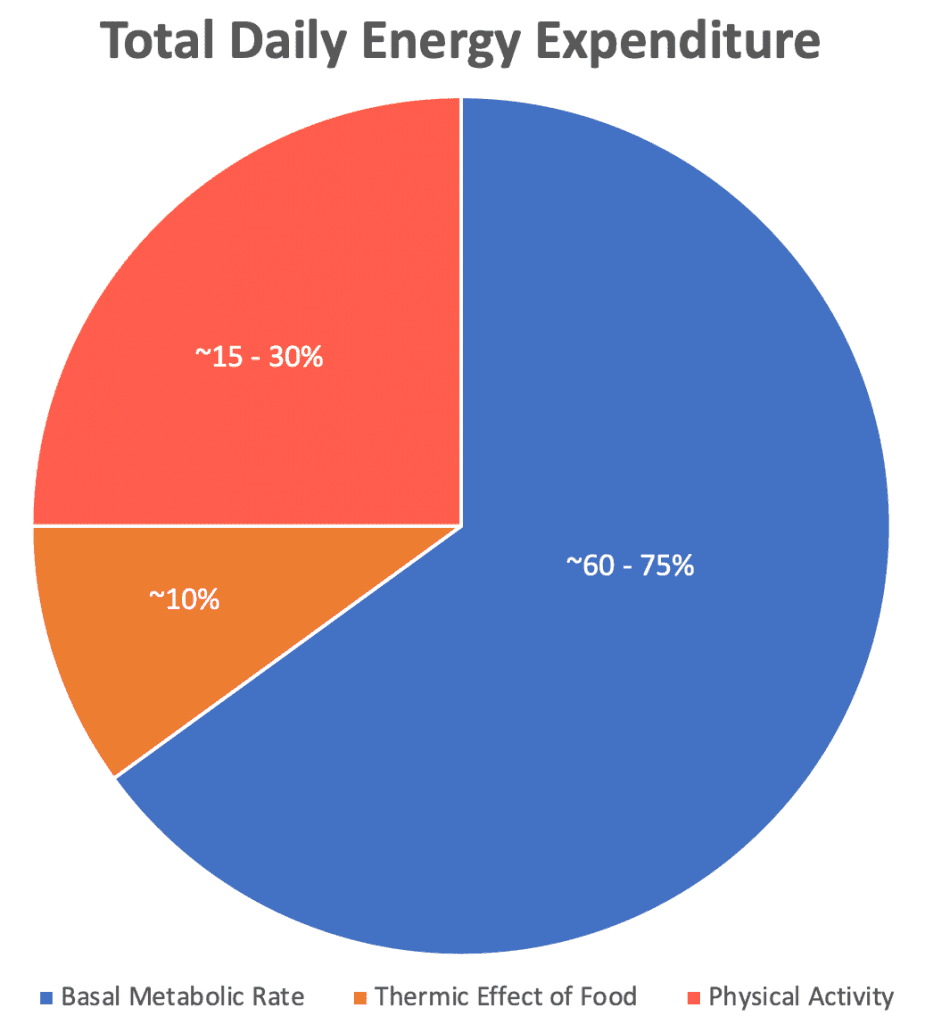Your total daily energy expenditure (TDEE) refers to the total amount of energy you burn each day. There are a number of factors which influence your TDEE, including:
- Basal metabolic rate (BMR)
- Thermic effect of activity (TEA)
- Non-exercise activity thermogenesis (NEAT)
- Thermic effect of food (TEF)
The TDEE calculator below includes BMR in its calculation. Click here if you want just the BMR calculator only.
Other health calculators on this site
- Protein calculator for weight loss and building muscle
- Macronutrient percentage calculator
- Lean body mass calculator
- Body mass index calculator
Total daily energy expenditure calculator
Basal metabolic rate
Your basal metabolic rate (BMR) refers to how much energy your body burns each day (measured in calories or kilojoules) just to keep itself alive. Your BMR comprises approximately 60 to 70% of your daily calorie burn behind the scenes.
Even when you’re asleep or sitting still, your vital organs like your brain, heart, and lungs are burning energy around the clock to keep your body on even keel.
Depending on your body composition (i.e., how much muscle or fat you have), your basal metabolic rate might be a little bit higher or lower.
Click here for the BMR calculator only.
Thermic effect of activity
The thermic effect of activity (TEA) refers to the energy you burn from exercise. This could include going to the gym and doing cardio or weights or playing sports like basketball, cycling, or martial arts.
For obvious reasons, the thermic effect of activity is going to vary from one person to another depending on specific activities and intensity levels.
Your combined energy burn from the thermic effect of food and non-exercise activity thermogenesis accounts for approximately 15 to 30% of your total daily energy expenditure.
Non-exercise activity thermogenesis
Non-exercise activity thermogenesis, or NEAT, is a fancy name that refers to the energy you burn from incidental movement. For example, climbing a flight of stairs, standing while you work, or walking a few blocks for a business meeting are not necessarily considered structured exercise. But the good news is, the more you do, the more they add up, and the greater your overall total daily energy expenditure.
There is a lot of excellent research on NEAT showing that it plays a significant role in helping to reduce risk factors for the development of obesity, diabetes, and heart disease.
Check out my related articles on non-exercise activity thermogenesis and inactivity physiology.
Thermic effect of food
The thermic effect of food (TEF) refers to the energy your body uses to process food. This includes breaking down, digesting, and absorbing food into the bloodstream where it can be used immediate energy or stored as fat for later use.
The TDEE formula
Taking all of the above on board, the formula for total daily energy expenditure is: TDEE = BMR + TEA + NEAT + TEF

Is the formula accurate?
It is important to understand that total daily energy expenditure is only an estimate and may not reflect your exact energy burn.
Does this mean you can’t trust it? Actually, no. It just means that you have to interpret it with a level head.
As free-living humans, we have some days where we’re more active than others, so your TDEE is going to vary from day to day, week to week, and month to month.
Factors that affect metabolism and TDEE
- Genetics – everyone is wired a little bit differently, so some people burn more energy than others.
- Age – metabolic rate is highest in fast-growing children but, as we reach our 20s and beyond, our metabolic rate gradually slows down.
- Gender – men tend to have higher metabolic rates due to a greater level of muscle and lower fat percentage compared to women.
- Body weight – the more you weigh, the higher your metabolic rate will be. Overweight people tend to have higher metabolic rates than leaner individuals due to there being greater overall body mass (muscle and fat) to maintain.
- Height – similar to with body weight, taller individuals have more overall mass to maintain and therefore higher metabolic rates.
- Starvation diets – wacky fad diets that induce large calorie restrictions can cause a large reduction in metabolic rate as a way to protect against the “famine.”
- Hormones – thyroid disorders can cause an increase or decrease in metabolic rate.
- Temperature – increases in both your internal body core temperature and the external temperature of the environment can cause increases in metabolic rate in an effort to cool and maintain internal homeostasis.
- Exercise – exercise can increase your metabolic rate, particularly after high intensity exercise which burns more calories during excess post exercise oxygen consumption (EPOC).
Using total daily energy expenditure for weight loss or gain
Once you have your total daily energy expenditure, how do you use it to plan for losing or gaining weight?
No matter what your fitness goal is, it’s important to be conservative and not drastically alter your calories overnight.
Your ancient genome is a lot smarter than you think and it has lots of creative ways to counter your efforts (i.e., the starvation response).
Check out my articles on the stupid sh*t that health marketers try to pull over on you to sabotage your goals:
- 37 Bullsh*t Health Marketing Phrases You Should Ignore
- Want to Lose Weight and Be Healthy? Then Stop Chasing Golden Unicorns
Lose weight
First off, healthy and sustainable fat loss is approximately 1 to 2 lbs (or 1/2 to 1 kg) per week.
To accomplish this, eat about 20% less than your total daily energy expenditure.
For example, if your TDEE is 2,500 calories per day, then you subtract 20%, or 500 calories, from the total which is about 2,000 calories per day.
A pound of fat (~ 1/2 kg) contains about 3500 calories of stored energy, so eating around 2,000 calories per day would plausibly lead to a reduction of about one pound of body fat per week.
Obviously it’s not a perfect science, but you get the idea. Bear in mind your activity levels will also play a role in energy balance, so if this feels too aggressive, you might start off with trimming off 10 to 15% to start.
Gain weight
On the other end, if you’re trying to gain weight then you’re no doubt trying to pack on muscle and keep fat to a minimum.
Following on from above, you might try adding 10 or 15% to your total daily energy expenditure to accommodate your increase in weight training at the gym.
If you have any questions about how much protein you should eat, check out my article on this topic:
Other health calculators on this site
- Lean Body Mass Calculator
- Macronutrient Percentage Calculator
- Basal Metabolic Rate Calculator
- Body Mass Index Calculator
- Interactive Bullshit Detector for Health Products & Services
- Interactive Fake News Detector
- Detox Decision Making Tool
Reference
William D. McArdle PhD, Frank I. Katch , Victor L. Katch. (2014) Exercise Physiology: Nutrition, Energy, and Human Performance. 8th Edition. Wolters Kluwer Health. Riverwoods, IL.

